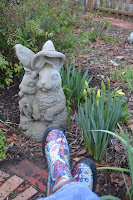I'll admit it. I get a lot of catalogs - the majority of which pertain to gardening, plants and seeds. Yesterday, I got a small periodical that had all sorts of women's clothing for gardening. Thinking that I needed special gardening clothes, I proceeded to look over the lavish styles made for hoeing weeds and planting seeds.

The summer section of the catalog featured a rather cute spaghetti tank-top shirt designed to suggest careless elegance and sexiness while gardening. This is a style my body type does not warrant. It would expose me to sun, mosquitoes - not to mention the neighbors.


The 'tops' section presented shirts that would make even your flowers swoon. Also described is a garden jacket with a paisley pattern on one side and quilting on the opposite. I am sure I will need a jacket here in Texas someday and after all paisley goes with flowers.
In the fall section, I found sweaters, scarves and knitted hats all for added warmth. One matched them with form-fitting trousers for a more casual appearance.


All of these fashions, that I must have just to make my garden grow, began to make my head spin and then I saw the cost of being stylish. This fancy schmansy style may look trendy but it could put me in serious debt.
Gardening in Texas is different. My own idea of garden fashion is jeans (shorts leave knees too exposed to cuts, bruises and bug bites). Mine
are dirty, frayed at the bottom, shredded at the knees and
comfortably baggy.
T-shirts with gardening slogans like 'gardeners do it in the dirt,' or 'give a weed an inch and it will take a yard' are my favorites. Brownish gray socks are the best because you can't tell when they are dirty. To keep my pedi looking good, I wear red
clogs bought at Canton First Monday Trades Days. I do have a pair of cutesy, wootsy, rubber
Wellies which are great for those wintry, rainy days.
Crocs that come in
bright colors are definitely a no no in the garden. The holes in their tops
lead to a whole host of wet and muddy problems. And, your feet will have a unique polka dot tan.
A hat is a must unless you want skin like a crocodile. Mine is a lovely pink wide-brimmed straw version which the
hummingbirds just love. Sunglasses are also a must. I buy them at the dollar
store because I either: 1) misplace them, 2) sit on them, or 3) lose them while
bending over the pond to feed the fish.
A garden fashionista must accessorize, right? My accessories include a bandanna to wrap around my forehead or
to wipe my brow when I sweat. I never glow. . .I sweat. For gloves, I swear by Atlas Nitril Touch (they come in 6 colors) and I get them at Lost Creek Gallery in Mineola.
Some gardeners wear a smart looking apron with pockets in
which to carry their tools. I tried one but my loppers kept piercing my stomach
and the belt tied around my waist just made me sweat more. I prefer to carry my
tools in a slop bucket that I brought home from my family’s farm. You do
remember what a slop bucket is, don’t you? I have never carried an English trug
(a small wooden basket that looks fashionable but holds nothing) because, after
all, THIS IS TEXAS.
Thank goodness the garden fashionista police can’t see me
when I garden because I look a little more like this. And, chances are if you visit my garden
you are dressed very
much like me.
You know, it could be worse. . . .
Garden on!








